

This report reflects on Tamarack’s journey through 2020 and our growth along the way. We are incredibly thankful to the 35,000+ learning partners in over 2,300 cities across Canada and beyond for being a part of this journey with us over the past year. In 2020, we created over 200 resources accessed by 111,531 individuals and produced 170 webinars, workshops and communities of practice - engaging over 26,715 changemakers. We cherish the opportunity to work together to navigate community change and to build vibrant places to live and grow.
Here's a quick summary of what you can find throughout the report.
Ubuntu. I am, because we are.
This year, in recognition of COVID we are trying something new and presenting you an online version of our annual report. As we shared in the opening of the 10-year plan we completed this year and are launching in this report. View Tamarack's 10-Year Plan.
“Tamarack exists because “you are”, our more than 34,000 learners and members. You live in more than 1,000 cities and communities in Canada and many more in the U.S. and around the world. The board and staff of Tamarack are as passionate about community change as each of you, and we are honoured to hold the space of learning and collaboration with you. You see us, you support us and validate that community and large-scale change is possible”.
Nothing better explains our intention which is to be - A connected force for community change. The year 2020 will forever be remembered as the year of COVID – a time where we locked down our communities to co-exist safely. Thousands of people died in our communities and we endured endless suffering. But we also saw the best in humanity arise as we supported one another and flocked onto online spaces to connect and learn together. Tamarack responded in ways we never thought possible and as an organization grew in unprecedented ways.
In the midst of all this chaos Tamarack’s board continued work on our ten-year plan and are making Tamarack 2030 public in this our online annual report (view plan here). As we celebrate our 20th Anniversary at Tamarack, we look both at our history and our future. We are excited about the next steps in Tamarack’s growth and impact.
Thank you for your ongoing support
Shauna, Brock, Liz and Paul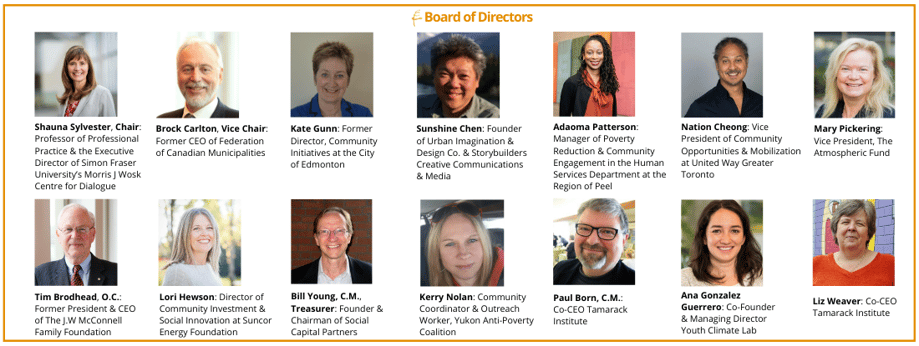
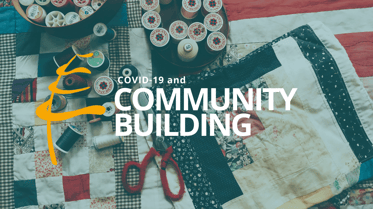 We’ve all learned a lot in the past year. It’s been hard. Week over week we’ve had to adapt and change and get used to a ‘new normal’. The team at Tamarack have been walking alongside communities from coast to coast to coast all the way through COVID and we have seen something remarkable: Despite obstacles, despite limited resources, despite ridiculously tired people, communities can get stuff done.
We’ve all learned a lot in the past year. It’s been hard. Week over week we’ve had to adapt and change and get used to a ‘new normal’. The team at Tamarack have been walking alongside communities from coast to coast to coast all the way through COVID and we have seen something remarkable: Despite obstacles, despite limited resources, despite ridiculously tired people, communities can get stuff done.
There seems to be something powerful about working at the community scale. People seem more willing to commit to make change when it is ‘their’ community. Place-based efforts allow for greater flexibility, innovation, and responses that fit their unique challenges during COVID. And there is a greater chance of addressing interconnected issues in practical ways at the scale of community.
We have followed the struggle of community and did our best to respond:
During the first 8 weeks of lockdown we created weekly updates to document and share how communities were responding.
We started offering online webinars every week and have sustained this throughout the year.
As people needed to learn more intentionally online, many new members found us and we grew by nearly 5,000 learners.
We took stock of what our Cities Reducing Poverty members were doing and shared this in a report, Cities Reducing Poverty: Responding to COVID-19.
We spoke about community as essential in article’s like When Community Becomes Unessential and papers like Collective Impact Post-Pandemic: A Framework for Response, Recovery, and Resilience.
The Tamarack board commissioned staff to write 10: A Guide for a Community-Based COVID-19 Recovery. This is a curated collection of 10 Really Good Ideas, 10 Inspiring Stories, and 10 Useful Resources designed to support changemakers like you to work at the community scale to get stuff done.
We determined that we could learn together in virtual ways and began launching our Foundations of Community Engagement course and monthly workshops on a variety of topics including collective impact 3.0 and co-design.
And more.
As an organization we want to first thank our staff who worked together through COVID and even reduced their work week to 4 days to ensure we could survive it financially. We are deeply grateful to our supporters including the Government of Canada for their support and concern. We recognize that the impacts of the pandemic are going to be with us for some time – but we have all pulled together and Tamarack will be there strong and supportive as we collectively work to rebuild our communities.
Over 18 months, Tamarack engaged more than 100 people—including our network members, staff, and board—to understand how Tamarack can best support communities to make deep and lasting change. The result of that effort is not a traditional ten-year plan, but instead a strategic framework which is organized around the north star of Tamarack’s vision and mission. It is an ambitious ten-year goal to make communities the drivers of transformational change, and a list of priorities and principles to guide the board, staff, and partners on the steps to get there.
We hope this plan excites you. For us it validated “who” we are as an organization and affirmed what we believe. It highlighted the need for us to do more for youth and that we must make the work of supporting cities as they navigate climate change a priority. This past year has taught us that we can no longer only talk about reducing poverty we must talk about ending poverty and the inequity and racism that is so much a part of the problem.
Over the next 10 years, Tamarack aims to contribute to an accelerated and dramatic shift in citizen-driven, place-based approaches to addressing complex challenges and improve community well-being at scale. We want communities to be recognized as the integral drivers of change and critical in building strong and inclusive societies.
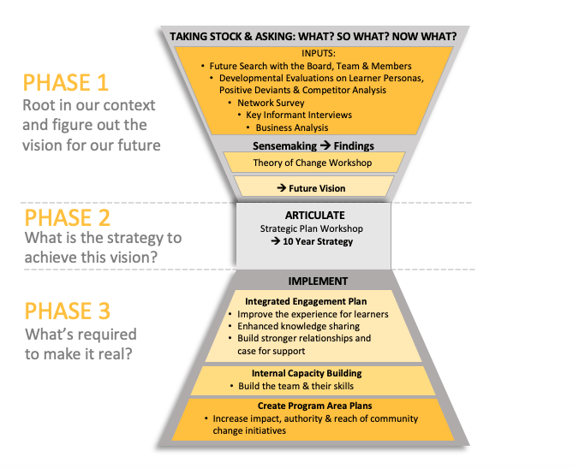
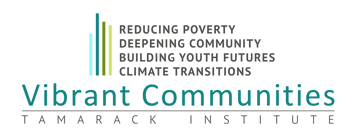 In Vibrant Communities, we support cities and local leaders to develop and implement large-scale community change initiatives through these learning networks:
In Vibrant Communities, we support cities and local leaders to develop and implement large-scale community change initiatives through these learning networks:
Cities Reducing Poverty (CRP) a network of 330 municipalities represented by 80+ regional members working collaboratively to end poverty in their communities.
Cities Deepening Community (CDC) a network of 67 cities seeking to strengthen neighbourhoods and 25 cities developing community plans to grow citizen engagement, civic leadership and a sense of belonging.
Communities Building Youth Futures (CBYF) a five-year strategy to work with 13 communities to develop system-wide solutions for youth as they build and act upon plans for their future.
Community Climate Transitions (CCT) is our newest campaign and will begin April 2021, stay tuned for more details.
COVID was a tremendous challenge for all of our members as they struggled to work toward a collective impact. Community engagement is central to their work and all members needed to shift to virtual/online approaches. Communities were under increased stress due to community lockdowns. Our partners worked to distribute food, find housing, combat loneliness and isolation and support youth through these challenging times.
Implementing CBYF was a huge challenge through COVID. Hiring staff, recruiting 13 communities in every territory and in most provinces, developing systems, and providing the training necessary to undertake a large-scale collective impact approach to social change. The team moved through this process with grace and the network is on track. We are confident many young people will achieve better futures because of this initiative.
The ultimate goal of Vibrant Communities is to create a learning network that makes the work of large-scale change in communities easier and more effective. We know the work is successful when communities can announce population-level outcomes that result in fewer people living in poverty, more people feeling a sense of belonging and actively contributing to their communities’ well-being, and that youth futures including graduate rates from high school, levels of unemployment, and youth optimism about their futures improve.
Large scale change scale is best measured by tracking population-level outcomes. Such change is complex and requires we understand and improve the conditions that block opportunity and those that enable opportunity.

Cities Reducing Poverty (CRP) is a powerful collective impact movement that has grown to support more than 330 municipalities represented by 80 regional roundtables. Members adopt collective impact approaches to drive long-term change and develop and implement plans to reduce poverty in their communities.
By the numbers:
CRP grew from 45 members and 1,200 changemakers in 2015, to 80 members and 6,337 changemakers in 2020
Between 2015 and 2018, CRP contributed to poverty being reduced for more than 1 million Canadians, and to significant reductions in Saint John (19.5% to 14.0%), Toronto (from 19.2% to 13.9%), and Winnipeg (from 15.5% to 12.0%)
Over the last 5 years, CRP hosted 69 webinars that attracted more than 10,000 learners
CRP hosted national events attended by over 2,000 people in Edmonton, Vancouver, Hamilton, Waterloo and Peel
CRP informed the development and rollout of British Columbia’s $5M Poverty Reduction Planning and Action program, which currently supports 14 CRP members
Cities Deepening Community is working with over 7,500 learners and 28 members from across Canada. These members and learners are working on building connections with residents, associations, and organizations to develop neighbourhood strategies.
Here are some of the areas of growth in 2020:
We have seen a growth from 15 to 26 members from across Canada. 3 in British Columbia, 5 in Alberta, 13 in Ontario, 4 in New Brunswick, and 1 in SK. What is exciting is that most of the membership increase took place during COVID
We altered our Community of Practices for April and May to bring all learners and members together to share their experiences during COVID. We held 8 brunch chats that connected 135 participants
Created a new podcast that addresses deepening community challenges. Starting with a Loneliness and Social Isolation series
Growth for overall CDC learners of 1,287 with a year-end total of 7,245
We currently have 580 participants representing over 150 cities across 10 provinces and North West Territories taking part in our Communities of Practice.
Communities Building Youth Futures (CBYF) works with 13 communities across Canada to engage youth facing barriers to education and employment and to develop strategies that enable young people to be engaged in their communities and successfully navigate transitions from youth to adulthood. These transitions might include the completion of a secondary school curriculum leading to a post- secondary education or apprenticeship experience or employment.
In the first 8 months:
1,330 youth are engaged in programs, leadership roles, staff positions, innovation projects, and engagement activities
470 local leaders come together regularly to address the needs of youth through collective impact
1,200 new partners and networks are working on strategies to support youth in their education to employment journey
Over 110 local leaders from the education and business sectors are contributing to the development of initiatives that support youth outcomes
896 learners attended our 3 public webinars, 123 attended 6 private webinars, and 127 subscribed to our newsletters
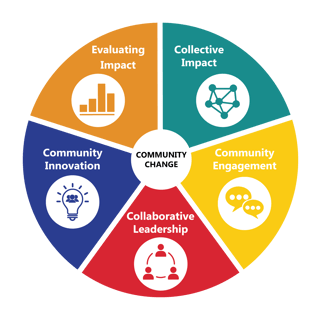 The year 2020 was a year in three parts. The first few months were, for many of us, business as usual with in-person learning events and meetings. By mid-March, the world was quickly changing. Many work environments moved to remote, in-person meetings moved to video conferencing, and everyone was unsettled by the uncertainty. Things began to change for a third time during the second half of the year starting in June as we settled into a new pandemic rhythm.
The year 2020 was a year in three parts. The first few months were, for many of us, business as usual with in-person learning events and meetings. By mid-March, the world was quickly changing. Many work environments moved to remote, in-person meetings moved to video conferencing, and everyone was unsettled by the uncertainty. Things began to change for a third time during the second half of the year starting in June as we settled into a new pandemic rhythm.
Tamarack learned many lessons during these phases. We ramped up our ability to connect virtually with our learners and partners. We shifted to a new type of learning and engagement that embraced the digital context. We explored what it means to weave the Tamarack learner experience into a digital environment. Our learners walked alongside us during this journey of change and adaptation.
Our Tamarack 2030 Strategy brings digital learning and engagement to the forefront. Tamarack learners and partners are looking for cost-effective, relevant learning experiences that they can access in real time or through asynchronous workshops. As a learning institute, we embrace this shift to digital environments while still seeking to support our learners through personalized connections, consulting, coaching, and leveraging communities of practice.
We know that the world will continue to shift post-pandemic, but responding to learning needs, expectations and experience will always be at the forefront of our work at Tamarack. We invited you into this digital environment and as you will see in the highlights, you responded by joining us in record numbers in 2020.
Sherreta Harrison, Sustainability Catalyst at MetroMorphosis described her teams experience participating in one of Tamarack’s virtual workshops on Collective Impact 3.0.
Our team thoroughly benefited from the time we spent with your team and feel better equipped to lead our change work. The tools shared, the presentation, and the ability to have conversation with so many diverse perspectives all have real import for the work we are doing in re-entry, education, economic inclusiveness, and community change.

Learning about Collective Impact continued to generate a high degree of interest with members of Tamarack’s learning community in 2020. Two Tamarack papers – Collective Impact 3.0 and Collective Impact Post-Pandemic were among the top five resources with our learners accessed in 2020. At the same time, our Introduction to Collective Impact and Effectively Launching a Collective Impact Initiative webinars were among the top 10 resources accessed by new learners visiting our site this year. This illuminates an interesting duality in the practice of Collective Impact. On the one hand, there is a growing network of seasoned practitioners whose work in Collective Impact is maturing and, on the other hand, there is still interest being generated with people who are just beginning their learning journey with this approach.
In 2020, Tamarack launched a Co-Design Workshop which enabled participants to learn how to engage broadly and deeply using a double diamond approach. Participants brought with them a ‘sticky issue’ - a challenge they were finding difficult to solve. Over two days, they engaged with tools and resources that moved them from being stuck on an issue that was challenging to solve to creatively moving through the challenge and toward impact.
Tamarack continues to explore the nexus between social innovation practice and community change. Increasing the skills and capacity of community changemakers through innovative approaches, human centred design and prototyping, communities can move from idea to impact.
Tamarack played a pivotal role in advancing collaborative leadership in 2020. Over 500 learners participated in workshops focused on turf, trust, and co-creation, deepening their practice of trust. The United Way of Leeds and Grenville, Every Kid in our Communities Leeds and Grenville and Food Banks Canada partners engaged in a Preparing to Pivot webinar series which has positioned them to meet the challenges facing their network now and enable them to pivot post pandemic. Collaborative leaders are focused on navigating the present, but with a systems vision, can also adapt to an unpredictable future.
2020 brought with it significant shifts in our landscapes, moving us from a place of status quo to a place of continuous reflection and innovation resulting from the pandemic context. The practice area for evaluating impact was greatly influenced by these ebbs and flows. To launch the practice area in early 2020, we published a paper focused on the landscape of participatory approaches to an evaluation practice entitled Strengthening Evaluation Literacy. From there, the opportunities for continuous reflection were grounded in several published articles throughout the year focusing on exploring Three Strategies for Navigating the Language of Evaluation, showcasing pivotal responses to the pandemic at the community level in Exploring a Community Youth Organization’s Rapid Response to the Pandemic, and deep diving into some critical reflection at the organizational and individual level about Equity & Inclusion: Stepping Into the Role of the Learner.
With the increased awareness of inequity and racism, and renewed commitment to reconciliation, we—along with many of our community partners—understand that community engagement offers a channel for lifting up voices of lived experience, creating spaces for authentic learning, and working towards an equitable distribution of resources, power and leadership. In July 2020, we released a paper on Understanding Community-Led Approaches to Change, and have committed to centering community voice and empowering community members to be active contributors and creators of the change they hope to see.
In early 2020, Tamarack finished the prototype of a learn-at-your-own-pace online course in the Foundations of Community Engagement. Tamarack had three key reasons for wanting to offer an online course:
To offer training to people in geographies we haven’t been able to support through in-person workshops (such as smaller communities and rural areas)
To offer foundational training in an accessible way allowing us to then focus our other events on more advanced topics
To respond to the learning preferences of a younger generation of changemakers
We were beta testing this new online course when the pandemic hit, which immediately brought to light the value in offering virtual training.
The Foundations of Community Engagement online course is designed to help practitioners build a solid foundation and equip them for Community Engagement work in their community. Through video lessons, case studies, readings, and activities, learners dig into understanding the role of community, who should be engaged, community engagement techniques, how to overcome challenges, and how to evaluate engagement activities. The course components include six modules offered through an online platform, course workbook to reflect and apply learning, and monthly group coaching office hours – optional discussion time where we invite learners to come with their community engagement questions.The learner feedback has been incredible.
Sue Van Sloten shared
“I’ve used the stuff I’ve learned, and it works like a charm. I know better what questions to ask, what language to look for, etc. Very worthwhile.”
Another learner shared
“I found it a really great resource, I’m very new to community engagement.”
Raymond Johnson-Brown reflected on the course after taking it with a group of colleagues:
“Any social service or community delivery program can benefit from the Foundations course, to find out how to engage and how to build up policies and systems that support that authentic engagement. Social services, ministries, government – there’s a lot of opportunity and groups that would benefit from the program.”
In 2021, we will be creating four more courses to provide a wider range of learning opportunities to our learners, including courses focused on Poverty Reduction, Community Building, Collective Impact, and Evaluation. We look forward to learning more about these topics with you over the coming year.
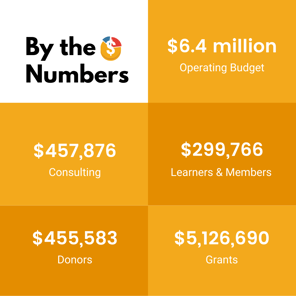
Our operations and finance team develops and maintains systems to ensure Tamarack is well run and that the Tamarack team can bring leadership to building better communities.
We are deeply grateful to our donors, grantors, and members for believing in us and providing us with the financial stability to be effective. We are also thankful to the individuals and communities that have attended our events, participated in custom workshops, and trusted us as consulting coaches. We have grown Tamarack together.
The Tamarack team and our Treasurer follow best practices in all our accounting procedures and are audited annually. Tamarack’s full audited statements are available upon request. Please email paul@tamarackcommuntiy.ca to request a copy.
The work of the Tamarack Institute is supported by an incredible community of learners, members, and donors that we are grateful to work with. When an individual or organization gives us a donation, contributes funding for a major project, works with our consulting directors, attends a workshop or becomes a Vibrant Communities member, they join us in partnership. These partnerships allow the Tamarack Institute to grow and make contributions to the important work of community change.
Over $100,000
Anonymous Donor
Employment and Social Development Canada
Government of Canada
Maytree Foundation
Suncor Foundation
The J.W. McConnell Family Foundation
$99,999 TO $10,000
Canadian Centre on Substance Use and Addiction
Chatham-Kent Children's Services
City of Prince George
Family Life Australia
Government of Yukon
Hamilton Community Foundation - The Young Fund
Illinois Action for Children
Kahnawake Collective Impact
New horizons For Seniors
Prosper Canada
Sewall Foundation
Southern Illinois Coalition for Children & Families
Town of Innisfil
United Way of Snohomish County
Universalia Management Group
Welborn Baptist Foundation
$9,999 TO $5,000
Big Brothers Big Sisters of Canada
Centre for Addiction and Mental Health
Chippewas of the Thames First Nation
Danville Regional Foundation
Head & Hands
inPath Project
McGill University
Mental Health Commission of Canada
Ottawa Food Bank
Parkland School District
Point in Time Centre for Children, Youth and Parents
Region of Peel - Public Health
South Australia Department of Human Services
STOPS to Violence
The Village Collective Impact Project
United Way Leeds & Grenville
United Way of Central Iowa
$4,999 TO $1,000
Alberta Health Services
Alliance for Healthier Communities
Alternatives Community Program Services
Ark of Freedom Alliance
BRIDGE Housing Corporation
Bruce Grey Poverty Task Force
Canada Helps
Canadian Forces Morale and Welfare Services
Canadian Mentoring Partnership
Canadian Poverty Institute
Carriage House Consulting, LLC
Catalyst Miami
Center for Nonprofit Management
Centre for Newcomers
Children’s Services Council of Palm Beach County
Christian Horizons
City of Airdrie
City of Burlington
City of Cambridge
City of Edmonton
City of Grande Prairie
City of Kawartha Lakes
City of Kelowna
City of Kitchener
City of Lethbridge
City of London
City of New Westminster
City of Powell River
City of Red Deer
City of Revelstoke
City of Spruce Grove
City of Toronto
City of Vancouver
City of Williams Lake
$500 TO $999
Carlton Victoria Inclusion Network
City of Oshawa
City of Prince George
City of St Albert
Cochrane District Social Planning Council
District of Mission
Greenway-Chaplin Community Centre
Grey Bruce Health Unit
Guelph and Wellington Task Force for Poverty Elimination
OpportUNITY for the Tri Community
Public Health Sudbury
Region of Durham
Renfrew County Child Poverty Action Network
South Kootenay Lake Community Service Society
Strathcona County
The Regional Municipality of Durham Housing Services Division,
Town of Amherst
Town of Strathmore
Yukon Anti-Poverty Coalition